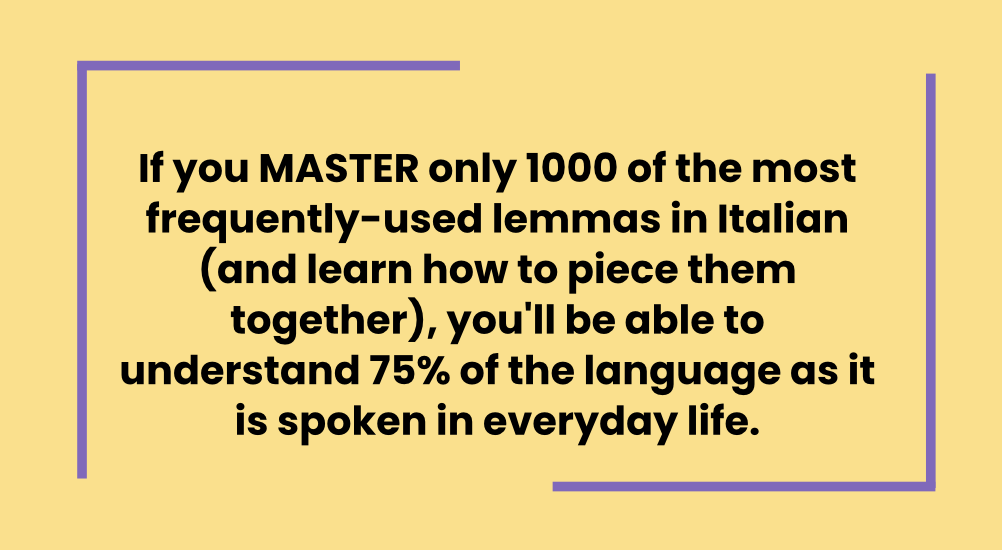STEP 1: Set a Learning Itinerary
What’s your Italian level? If you have been studying Italian for a few months or even years and you don’t know where you are at, that’s a problem. In order to make progress and learn Italian fast, you’ll need to know what learning material (e.g. textbooks, podcasts, youtube videos) is better for you.
You can’t just listen to a random podcast or enroll in a random class and hope for the better, because there’s a fair chance that the material you’ll get (e.g. grammar, vocabulary, listening tracks) won’t be the best for your level. This could turn your investment into a waste of money and time.
Instead, do this..
- Get your Italian level assessed (I have some free tests available for free on this page).
- Select a textbook that is perfect for your level and learning style. This way, you’ll have a clear path lined up for yourself, and you’ll know what to study and what to focus on. For instance, if you want to progress from beginner level (A1) to elementary level (A2).
The CEFR Levels – the Common European Framework of Reference for Language Learning
To help you navigate levels and milestones, this is the European scale for languages. Keep this chart in mind and set a goal for yourself to reach the next level.

You can read more about the specifies and milestones of every levels on this page.
If you search online, you’ll find information about the number of hours that have been calculated to complete an A1 or B1 level. However, I believe that this amount can be reduced or increased based on the effort and time you’re able to put it.
STEP 2: Emphasize the Foundations
Don’t rush through beginner Italian, as that’s the most crucial part of your journey. It has been proven that native speakers tend to use the most basic grammar and vocabulary patterns repeatedly in day-to-day conversations, and those are the aspects you need to master from the outset. Focusing on mastering the Italian foundations (A1-A2) is paramount if you aspire to become a proficient speaker of Italian or just conversational.
Do this:
- Check the syllabuses for the A1/A2 programs.
- Get a beginner grammar textbook.
- Practice until you have mastered it.

STEP 3: Immersione and Practice
Do you need to live in Italy to learn to speak Italian? No! That’s, in most cases, an excuse for not taking action. How many times have you visited Italy for a couple of weeks hoping that your Italian would improve and it didn’t? As a tourist or even as an expat living in Italy, the chances of having immersive conversations are few and far between (unless you’re a high school student enrolling in a class filled with Italian teenagers!)
You don’t need to live in Italy to become proficient.
What you need, is to surround yourself with the best Italian resources at home.

Test Your Italian
Not sure what your Italian level is? I’ve created a free online Italian test to help you determine it.How to speak Italian better and learn faster at home:
- Join an Italian conversation group (check out my Italian Speaking Club) or take private lessons with a tutor (get 50% OFF your first speaking class with Preply with this link).
- Read graded-readers in Italian, such as short stories (commit to reading once a month) or children books. Make note-taking a habit. If you don’t what easy readers are, check out this post.
- Listen to Italian podcasts or radio shows (a comprehensive list of Italian podcasts for beginners and intermediate levels here)
- Watch Italian TV shows and find influencers (a comprehensive list some well-known Italian TV shows on link here)
- Read magazines (my favorite Italian magazines that you can buy online too, list here)

Among the items listed above, the first two are more important.
Why?
Because they provide a sense of structure and they are not passive learning activities. In order to speak a foreign language, you should place your focus especially on the active aspects of producing a language. While YouTube or Netflix content can sometimes be scattered, and while it can help you maintain your Italian, it might not give you the push you need to make significant progress.
7 Common Mistakes Unsuccessful Language Learners Make, AKA a guide to slowly learning Italian.
I speak from my own experience of being a student of seven foreign languages and teaching Italian for the past 12 years.
- Spreading yourself too thin: doing too much without setting a strategy or prioritizing what you need. Focus on what you need, master it and move on.
- Believing that buying a course will magically solve all your problems is a misconception. There’s no such thing as a one-size-fits-all solution. Learning a foreign language requires various inputs, such as using a textbook, reading simplified materials, speaking with a tutor, and more.
- Not knowing your level AKA not knowing what you need to work on.
- Using the wrong methods/teachers for your learning style and needs.
- Focusing solely on vocabulary (instead focus on how to piece bits and pieces of vocabulary together, for example by reading graded-readers )
- Not using a textbook (I mean…for real?)
If you follow the first THREE steps I’ve outlined (just three of them!) and avoid falling into the above pitfalls, you’ll notice your Italian improving FAST. If you don’t, feel free to email me and let me know why.







